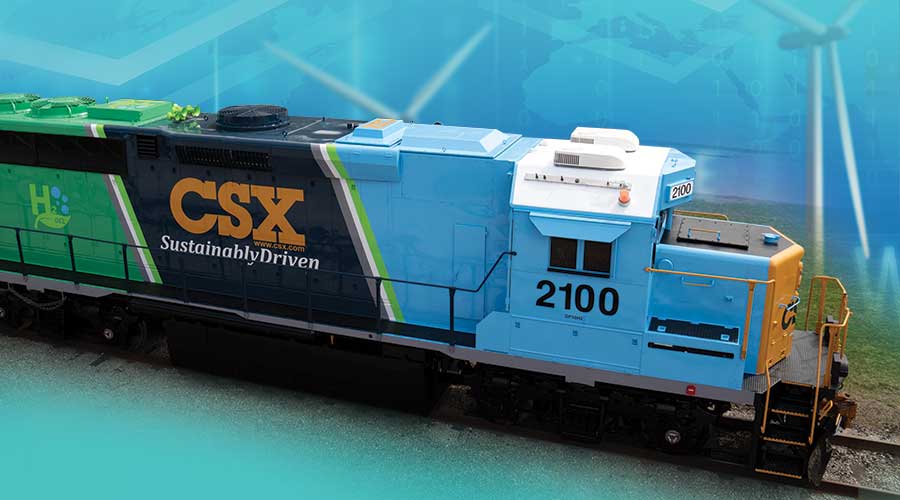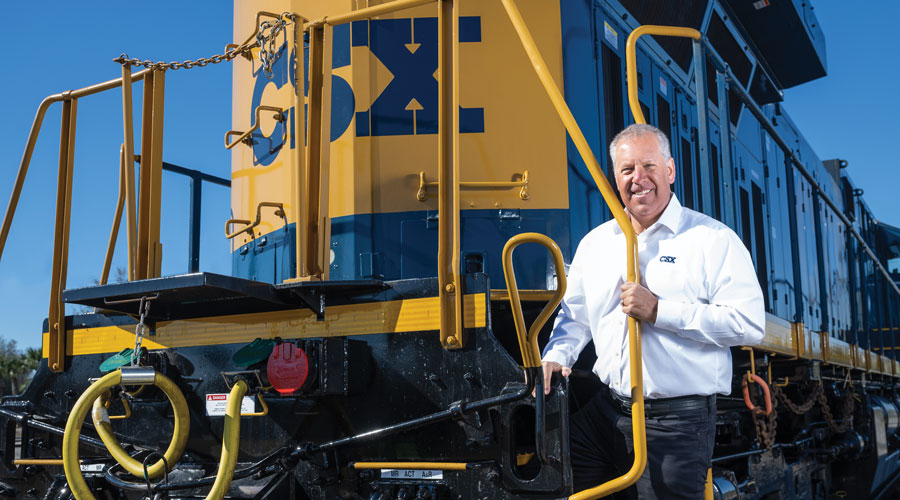Stay updated on news, articles and information for the rail industry
November 2016
Rail News: CSX Transportation
For CSX, a workforce of the future is an integral part of a 'railroad of tomorrow'
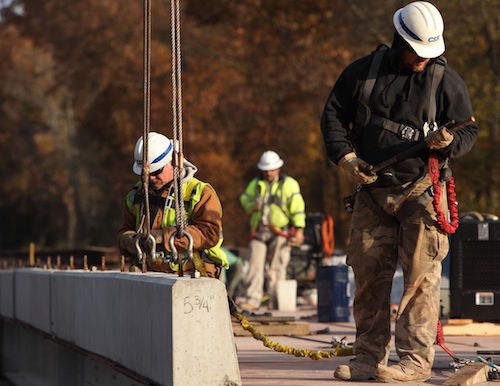
By Jeff Stagl, Managing Editor
Coal isn’t king for CSX anymore. The commodity now generates a small portion of the railroad’s annual revenue instead of the lion’s share.
So, the Class I is in the early stages of adopting a “CSX of Tomorrow” strategy that calls for realigning its network to de-emphasize coal traffic, and optimize intermodal and merchandise business; deploying more automation; and honing service performance to boost reliability and responsiveness. To learn more about the strategy, read this cover story in Progressive Railroading’s November issue.
There’s one other main component of the CSX of Tomorrow: a Team of Tomorrow (ToT). To help carry out the strategy, the Class I seeks to develop a more diverse, versatile and highly skilled workforce. Such a team will up the ante on working collaboratively, making decisions quickly, embracing new technologies and finding ways to boost productivity, says CSX Senior Vice President and Chief Administrative Officer Cressie Brown.
But first, ToT developers are defining what skillsets employees need to be an integral part of the CSX of Tomorrow.
Some important traits: that they be innovative, to think outside the box; flexible, to help flex CSX’s resources; and geared toward service excellence, which is vital “because of the service-sensitive markets we’ll be in,” says Brown. Ultimately, CSX aims to get beyond traditional promotion schemes and training programs to help employees develop new skills in such critical areas as emerging technologies, analytics and customer insight.
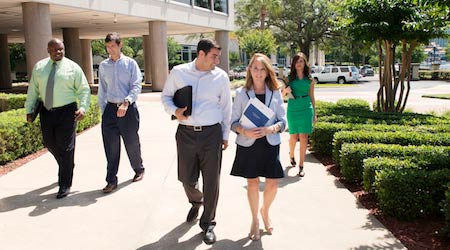 CSX now is conducting "unconscious bias" seminars for its 2,500 managers and department leaders that are designed to help them better understand some preconceptions that might surface in their decision-making. CSX
CSX now is conducting "unconscious bias" seminars for its 2,500 managers and department leaders that are designed to help them better understand some preconceptions that might surface in their decision-making. CSXDeveloping a ToT in part calls for establishing a talent pipeline to retain the most experienced and skilled employees who contribute at a high level, and recruit the brightest and most proficient new workers, says Brown. To get such a pipeline flowing, CSX aims to make tweaks and/or major changes to its career development, training and recruiting programs.
In terms of retention and career development, the railroad in late 2015 launched an employee valuation initiative to “get our hands around the Team of Tomorrow,” says Brown. The initiative involved employee interviews, focus groups and research to determine why people joined CSX and why they stayed at the company. The feedback will help identify ways to retain valuable and experienced workforce members.
“We have a generationally diverse workforce, with Millennials, Gen-Xers and Baby Boomers,” says Brown.
Through the initiative, CSX determined workers’ basic values didn’t change much — traditional pay and benefits still were draws.
"But we found there was a challenge: work-life balance,” says Brown.
Now, ToT developers are molding platforms to prompt more defined and desirable career paths, and provide the necessary tools and training. The platforms are expected to be in place by year’s end or in early 2017, at which time various resources will be available for employees.
As part of the ToT, some workers could move laterally in their jobs or completely change the direction of their career. In addition, new types of jobs could be created and available as the railroad transforms into the CSX of Tomorrow, perhaps by combining the tasks of two current jobs.
Some of the resources workers need to change or remold their jobs are or soon will be available electronically on CSX’s “Employee Gateway” portal, including a talent and development resource guide, learning management system and career progression planning tool.
There also are new resources for supervisors that factor into the ToT. CSX now is conducting “unconscious bias” seminars for its 2,500 managers and department leaders that are designed to help them better understand some preconceptions that might surface in their decision-making, or during meetings and conversations with workers.
Such an unconscious bias could be the perception that a person’s gender might impact their performance at a particular job. Removing the biases will create a more diverse and engaged workforce, improve decision-making and enhance innovation efforts in support of the CSX of Tomorrow, says Brown.
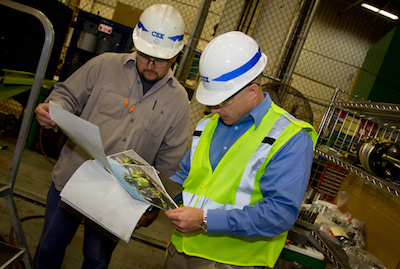 Team of Tomorrow members will be more open to collaboration and innovation, CSX believes. CSX
Team of Tomorrow members will be more open to collaboration and innovation, CSX believes. CSXTo further engage and develop the workforce, the railroad is transitioning to experiential, hands-on training methods. For example, CSX is piloting several virtual reality (VR) programs that cover a variety of rail topics, including bridge structures, locomotives and welding. The bridge program provides engineering employees realistic, 360-degree, interactive scenarios on any structure in CSX’s network — a safer alternative than physically exposing trainees to such rail infrastructure.
Other VR programs enable a trainee to wear goggles to perform welding tasks and receive a score on their technique, or to learn the devices and equipment in a locomotive cab, says Brown.
“It’s a quicker way to get acclimated to welding and other tasks,” she says. “[And] they can get a feel for a locomotive cab.”
Employing high-tech training techniques figure to boost recruiting efforts, too. Young workers — who are accustomed to video games, smartphones and the latest computers — seek advanced technologies at potential employers, says Brown.
In that regard, the Class I is employing video conferencing for interviews and conducting virtual job overviews. In addition, the railroad is trying to use social media in novel ways for recruiting, such as by sharing employees’ stories and explaining their roles at CSX. The method is particularly focused on non-operations-based jobs, including sales and marketing, finance and information technology.
To get better at recruiting, CSX is analyzing where efforts are focused and scrutinizing the current testing and screening process. Before there’s a ToT, some additional strides will have to be made as to how the railroad attracts and lands good candidates.
"We need more flexible ways to recruit, not just the traditional ways,” says Brown.
Keywords
Browse articles on CSX Team of Tomorrow rail laborContact Progressive Railroading editorial staff.


 LRW Honors Amtrak’s Acheson As Railway Woman Of The Year
LRW Honors Amtrak’s Acheson As Railway Woman Of The Year
 From Editor-In-Chief Foran: Of Gender Equity And Inclusion
From Editor-In-Chief Foran: Of Gender Equity And Inclusion
 Spotlight On Some Of Today’s Rail Safety Products
Spotlight On Some Of Today’s Rail Safety Products
 Women of Influence in Rail eBook
Women of Influence in Rail eBook
 railPrime
railPrime




